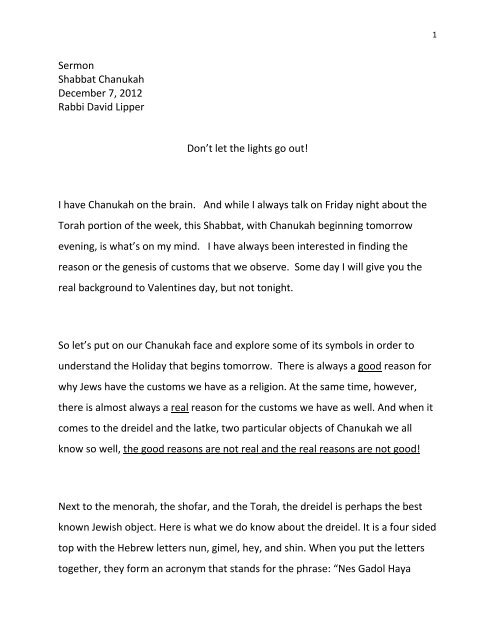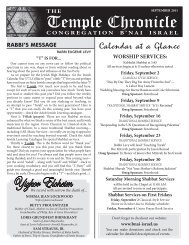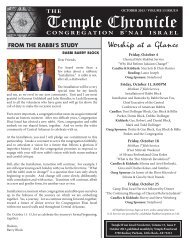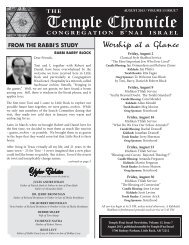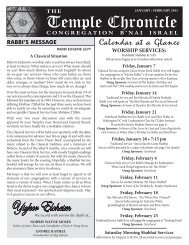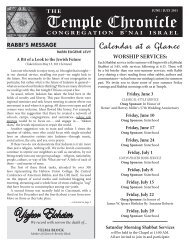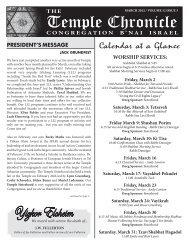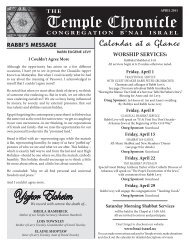Sermon Shabbat Chanukah December 7, 2012 Rabbi David Lipper ...
Sermon Shabbat Chanukah December 7, 2012 Rabbi David Lipper ...
Sermon Shabbat Chanukah December 7, 2012 Rabbi David Lipper ...
Create successful ePaper yourself
Turn your PDF publications into a flip-book with our unique Google optimized e-Paper software.
1<br />
<strong>Sermon</strong><br />
<strong>Shabbat</strong> <strong>Chanukah</strong><br />
<strong>December</strong> 7, <strong>2012</strong><br />
<strong>Rabbi</strong> <strong>David</strong> <strong>Lipper</strong><br />
Don’t let the lights go out!<br />
I have <strong>Chanukah</strong> on the brain. And while I always talk on Friday night about the<br />
Torah portion of the week, this <strong>Shabbat</strong>, with <strong>Chanukah</strong> beginning tomorrow<br />
evening, is what’s on my mind. I have always been interested in finding the<br />
reason or the genesis of customs that we observe. Some day I will give you the<br />
real background to Valentines day, but not tonight.<br />
So let’s put on our <strong>Chanukah</strong> face and explore some of its symbols in order to<br />
understand the Holiday that begins tomorrow. There is always a good reason for<br />
why Jews have the customs we have as a religion. At the same time, however,<br />
there is almost always a real reason for the customs we have as well. And when it<br />
comes to the dreidel and the latke, two particular objects of <strong>Chanukah</strong> we all<br />
know so well, the good reasons are not real and the real reasons are not good!<br />
Next to the menorah, the shofar, and the Torah, the dreidel is perhaps the best<br />
known Jewish object. Here is what we do know about the dreidel. It is a four sided<br />
top with the Hebrew letters nun, gimel, hey, and shin. When you put the letters<br />
together, they form an acronym that stands for the phrase: “Nes Gadol Haya
2<br />
Sham” or “A great miracle happened there”. On <strong>Chanukah</strong>, it is customary to play<br />
a little gambling game using this top to celebrate this joyous holiday.<br />
But why do Jews play dreidel? In other words, where does the dreidel come<br />
from? When did it start and why? Did Judah Maccabee start the tradition? Was it<br />
a custom created by the rabbis of the Talmud? If so, why a top and why<br />
gambling?<br />
So here is the good reason for why we play dreidel, the reason we always hear.<br />
Dreidel was created a long time ago out of a need to be able to teach and pass on<br />
our faith when it had to be passed on in secret. During Roman times, when the<br />
study of Torah was outlawed, Jews had to find ways to fool the authorities and<br />
teach our faith when it was dangerous to do so. Thus, Jews created dreidel and<br />
other types of innocent games that could be played without arousing suspicion<br />
from the authorities. Dreidel conveyed the meaning and message of the holiday<br />
and allowed the story of <strong>Chanukah</strong> to be told without fear of discovery. Good<br />
reason.<br />
Unfortunately, it is not the real reason. In fact, the dreidel originally had nothing<br />
to do with <strong>Chanukah</strong> and actually had more to do with the Christmas season!<br />
Here is the real reason we play dreydl. In the winter (around Christmas time) in<br />
England and Ireland, a popular game called totum or teetotum was created.
3<br />
Totum was a game that started in the 1500’s to pass the time during the long<br />
winter season. Totum was a four sided top used for gambling with four letters; T<br />
(take all), H (take half), P (put down) and N (get nothing). In Eastern Europe, a<br />
similar game grew out of this totum and German letters were added to this<br />
pastime: “ N (Nicht/ Nothing), G (Ganz/All), H (Halb/ Half), S (Shtel-in/ Put In). In<br />
Germany, the game was called “trundle” and when Jews started playing it, they<br />
put Hebrew letters on it and called it in Yiddish “varfl” ( to thrown in) or a<br />
“dreidel” (to spin).<br />
So dreidel has its origins in England around Christmas time and later in Germany.<br />
Oh, and don’t delve too deeply into the history of the latke, either. If you take<br />
some measure of pride in that Jewish delicacy, you will likely lose your appetite<br />
for it. Here, too, while the good reason is that the latke was created by Jews to<br />
celebrate the miracle of the oil• (since the potato pancake is fried in oil), it<br />
actually didn’t start with us. The “latke”• was actually a popular winter dish<br />
common throughout much of Poland centuries before Jews even got there. We<br />
took it and grafted it into our culture as well. Like the dreidel, the latke is not<br />
Biblical, Talmudic or even Jewish. It is no more Jewish than a hamburger.<br />
Now, why am I doing this to our <strong>Chanukah</strong> traditions? Because I think this teaches<br />
us something very important about Judaism and Jewish survival.
4<br />
<strong>Chanukah</strong> celebrates the story of the Jewish people rising up against those who<br />
would wanted to purge us of our heritage. It is the story of the Syrian-Greeks, in<br />
the year 165 B.C.E., defiling our Temple, trampling our religious way of life and<br />
demanding that we assimilate and become Hellenists. They wanted us to give up<br />
our identity and our religion.<br />
You might think it ironic, therefore, that on this very holiday which celebrates<br />
victory over assimilation, that we play the dreidel game and eat latkes which are<br />
perfect examples of assimilation. After all, are we not using a game that was<br />
popularized by Christians and eating a delicacy from a culture that was not our<br />
own?<br />
But my point is that Jews have survived because our people have been adept at<br />
making a distinction between assimilation and acculturation. Assimilation is the<br />
cultural absorption of a community into the main cultural body. Acculturation is<br />
adapting to new and different cultures and surroundings, being influenced but<br />
not swallowed up by those cultures. Acculturation is the only way to<br />
survive as a minority.<br />
Jews have always had to battle to survive as a people. Christians, with nearly two<br />
billion followers, do not worry about their survival, nor do a billion Muslims, but
5<br />
the tiny Jewish minority of just fewer than 14 million worldwide have always been<br />
embattled. When we weren’t being persecuted, we had to find ways to keep<br />
ourselves distinct and avoid disappearance. When we weren’t fleeing for our<br />
lives, we had to answer: how can we survive as a people without assimilating?<br />
And for the last two thousand years, the Jewish religion has been able to survive<br />
precisely because Jews have successfully acculturated to society, adapting our<br />
heritage and faith to our surroundings. We like to think of Jews surviving because<br />
we were stubborn and refused to adapt to the surrounding cultures. Just the<br />
opposite! The truth of the matter is we successfully found ways to take aspects of<br />
every society we lived in and incorporate them into our own practices.<br />
That is the meaning of dreidel, latke and a whole host of customs and tradition<br />
we do to this day. They were never part of the Torah, the Talmud or even the<br />
Codes of Jewish Law. They were traditions of the societies we lived in; we<br />
adopted them and adapted them into our world to be used to keep our faith and<br />
our people alive. We took the totum and made it a dreidel. That is not<br />
assimilation; that is acculturation and there is nothing wrong with that.<br />
Acculturation is the only way a minority can survive.<br />
Think I am wrong? Look at how Jews took the German language, added Hebrew<br />
letters and created Yiddish; we also took Spanish, added Hebrew and created<br />
Ladino. Jews in Middle Eastern cultures created a more Eastern form of Jewish
6<br />
expression and Jews in Europe created a more Western influenced faith, from the<br />
foods we ate to the language we spoke to the prayers we recited. The religious<br />
“core” always stayed the same but the “trappings”• changed to conform to the<br />
societies they were in.<br />
The very key to our survival is found in the dreidel and the latke. The Jew didn’t<br />
assimilate, nor did he drop his heritage, but acculturated to the society he was in<br />
and found new ways to practice the faith of his ancestors. When faced with the<br />
challenge of survival, the Jew always acculturated as a way of maintaining his<br />
identity. Acculturation is how a people survives.<br />
Acculturation is what Jews have done for centuries, from eating a Polish Potato<br />
Pancake and making it a <strong>Chanukah</strong> tradition, to taking a popular Christmas-time<br />
toy called totum and making a game that tells the story of <strong>Chanukah</strong>.<br />
That’s the way we survive as a people!<br />
Chag Urim Sameach …. A Happy <strong>Chanukah</strong> to all<br />
<strong>Shabbat</strong> Shalom<br />
Adapted from sermons written by <strong>Rabbi</strong> I.B. Koller, <strong>Rabbi</strong> Emeritus of Congregation B’nai Israel,<br />
Charleston, W.Va., and <strong>Rabbi</strong> Victor H. Urecki of B’nai Jacob Synagogue in Charleston, W. Va.


